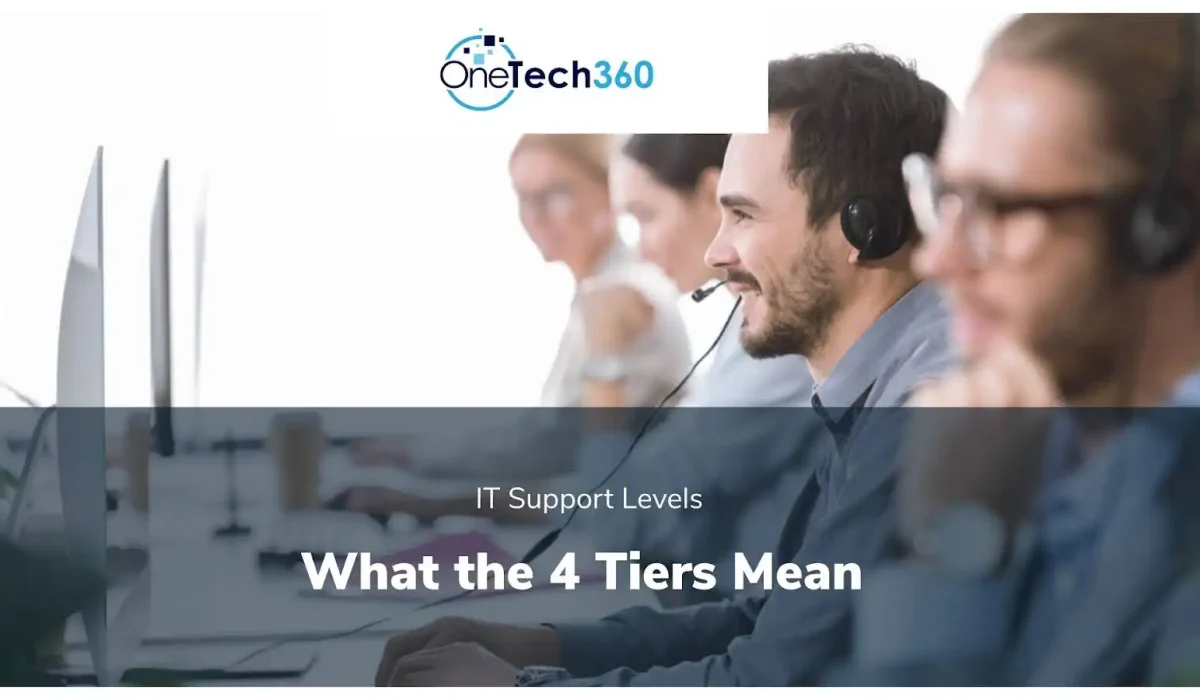If technology problems are slowing down your employees and hurting your business, it might be time to consider hiring a managed IT services company with clear IT support tiers. This lets you hand over your IT support tasks so your team can concentrate on achieving business goals.
Says Luis Aponte, CEO, “Understanding the layers of IT support tiers is the first step in crafting a tech support strategy that ensures resilience against tech disruptions.”
Before you decide on an IT support service to outsource to, make sure you know what kind of help they’ll provide under their service agreement.
Technology issues can be as minor as a single broken laptop or as major as a problem that stops your whole business in its tracks and needs fast fixing.
Most managed IT service providers use a system with different levels of IT support to ensure they offer the best service to their clients. This system helps both the client and the support team prioritize and deal with problems based on various criteria.
How MSPs Use IT Technical Support Tiers
To do this, IT providers categorize their support into four levels, known as tiers 0 to 3.
Your contract with a managed IT service provider (MSP) should clearly explain how they decide which tier to place your support needs in.
Some MSPs use a person, called a dispatcher, to review and direct support tickets to the right tier. Others use software to automatically sort and assign support requests to their team.
In both cases, they often look at how serious the issue is and how many people it affects to decide which tier should handle it. Your contract should also include a service level agreement (SLA) for each tier, outlining what you can expect.
We’ll look into the different tiers of IT support, why they matter, how they work, and the role of the support structure in helping your business.
Explaining IT Support Tiers in Detail
What is the difference between IT support tiers? In recent years, the explanations for each level of tiered IT support have become more uniform.
This change helps avoid misunderstandings between managed service providers and their customers, making it easier for people who aren’t tech experts to compare IT support contracts.
Tier 0
Let’s begin with support Level 0 or Tier 0, which is all about helping yourself. Usually, this means you can find help and support on an online knowledge base or client portal that you have access to.
Tier 0 support also covers things like help forums or online videos that teach you how to fix basic tech problems by yourself, step by step.
Real-world scenario: Imagine someone who’s having trouble setting up their email on a new phone. Instead of calling tech support, they go to their service provider’s website and find a step-by-step video guide in the self-help section.
By following the video, they successfully set up their email without needing to speak with a support agent. This is a classic example of using Tier 0 support.
Tier 1
The next step, Tier 1 or Level 1, is your basic help desk support. This covers things like resetting usernames and passwords or dealing with minor hardware and software issues.
Usually, this involves support staff walking clients through easy solutions. But if the issue is too complex, it gets passed on to Tier 2. Here, more skilled technicians take over to provide deeper help.
Real-world scenario: Imagine someone who can’t log in to their work software because they’ve forgotten their password. They call their company’s help desk, and the support person on the other end helps them reset their password.
The whole process is quick and straightforward, solving the technical problem without needing to dig deeper into more advanced technical issues.
Stop Waiting on Hold!
We resolve issues in as little as 11.3 minutes and get your team back to work
Tier 2
Tier 2 or Level 2 support deals with complicated problems that need a closer look to find out what’s really wrong. These issues usually affect the whole company’s products or services, not just simple things like password resets.
This level is handled by technicians with more experience, and they often need to remotely access devices or spend a lot of time with the client to solve the problem. Many of the help desk requests end up in this category because they require this deeper level of assistance.
Real-world scenario: Imagine a company where all employees suddenly can’t access their email system. This isn’t a simple fix like a password reset; it suggests a bigger problem with the email server or network.
A Tier 2 support technician would step in to investigate, using their expertise to diagnose the issue, which might involve remotely accessing the server, checking network settings, and making technical adjustments.
Their goal is to find and fix the root cause so everyone can get back to using their email.
Tier 3
Finally, the top tier, Tier 3, gives you help from very skilled technicians, often engineers, who tackle the toughest and most urgent tech problems. These problems might require reinstalling software or fixing major hardware issues.
Tier 3 issues can affect many employees across a company or relate to a crucial business application. This support level is handled by highly experienced engineers who sometimes need to work with software or hardware companies to solve difficult issues.
Usually, a problem reaches Tier 3 after technicians in the lower tiers have looked at it and decided it needs more expert attention.
Real-world scenario: Consider a scenario where a company’s specialized software, critical for its operations, suddenly stops working correctly, causing significant disruption. This software is customized for the company’s needs, and the issue is neither a simple bug nor a minor glitch that can be quickly fixed.
After initial attempts by the first and second levels of support fail to resolve the problem, the case is escalated to Tier 3. Here, highly skilled engineers who have deep knowledge of the system get involved.
They might discover that the problem is due to a conflict between the latest software update and the company’s unique configuration. To fix it, they work closely with the software’s developers, potentially modifying the code or creating a custom patch.
|
More resources you might like: |
What Are the Benefits of Having Multiple Tiers of IT Support?
The key to the IT support tiers model is providing excellent customer service. This model helps companies that provide IT help desk support as a service to quickly fix small and simple IT problems, ensuring customers are happy.
A clear tiered support system makes it easier to handle more complicated issues efficiently, speeding up responses and sending the toughest cases to the most qualified technicians.
This setup also helps the service provider clearly explain to clients what to expect, so there are no surprises about how long services will take.
When looking for an IT support company, you should ask about their policy on tiered support and their service level agreements. Remember, some companies match their support tiers and SLAs closely, while others handle them differently.
Make sure you know how your support agreement works, including how to get in touch with customer support if your employees run into tech issues.
You can usually contact outsourced IT help desk teams through a portal, website form, email, live chat, or phone. However, access might be limited based on your service level agreement.
For instance, at a basic service level, help desk support might only be available during business hours, while a more comprehensive service package could offer 24/7 support all year round. It’s important to understand what your contract includes.

All Tiers of Support, One Proven Partner
At NetWize, our support team is experienced in helping businesses of all sizes, small, large, and specialized. We have certified technicians ready to help you 24/7.
| Expert IT Support Near You |
We’re committed to providing excellent customer service and offer fast resolutions, including quick escalation to our highest level of support when necessary. We can also send technicians to your location for on-site help if needed.
To learn more about the different levels of IT support we provide, get in touch with us today to set up a meeting.





2 Responses